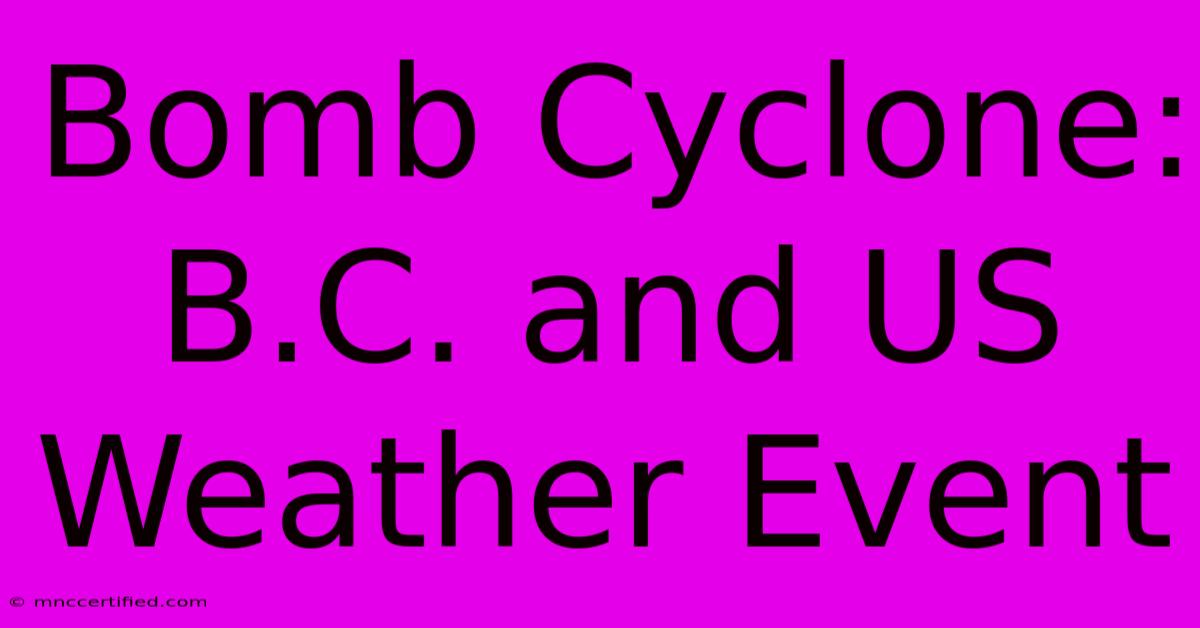Bomb Cyclone: B.C. And US Weather Event

Table of Contents
Bomb Cyclone: Devastating Weather Events in B.C. and the US
A bomb cyclone, also known as explosive cyclogenesis, is a rapidly intensifying mid-latitude cyclone. These storms are characterized by a dramatic drop in atmospheric pressure, leading to severe weather conditions. While they can occur globally, the impacts on British Columbia (B.C.) and the United States have been particularly devastating in recent years. This article delves into the formation, impacts, and forecasting of bomb cyclones affecting these regions.
Understanding Bomb Cyclone Formation
Bomb cyclones require specific atmospheric conditions to form. A key ingredient is a pre-existing low-pressure system interacting with a strong temperature gradient – a significant difference in temperature between two air masses. This temperature contrast fuels the storm's intensification. As cold, dry air collides with warm, moist air, a process called baroclinic instability occurs. This instability leads to the rapid development of a powerful low-pressure center. The defining characteristic of a bomb cyclone is its rapid pressure drop: at least 24 millibars (mb) in 24 hours. This rapid intensification is what generates the extreme weather associated with these events.
Key Factors Contributing to Bomb Cyclone Development:
- Strong Temperature Gradient: A sharp contrast between cold and warm air masses provides the energy for the storm's intensification.
- Atmospheric Instability: Unstable atmospheric conditions allow for rapid upward movement of air, further fueling the storm.
- Upper-Level Support: Favorable upper-level winds can enhance the storm's development and intensify its circulation.
- Moisture Availability: Abundant moisture in the warm air mass contributes to heavy precipitation.
Impacts of Bomb Cyclones on B.C. and the US
Bomb cyclones unleash a range of severe weather hazards, posing significant risks to both B.C. and the US. These include:
- Heavy Snowfall: Intense snowfall can lead to widespread power outages, transportation disruptions, and hazardous driving conditions. Mountainous regions in B.C. and the US are particularly vulnerable.
- High Winds: Strong winds can cause damage to infrastructure, uproot trees, and lead to coastal flooding. Coastal communities in both regions are at increased risk.
- Coastal Flooding: Storm surges combined with high tides can inundate coastal areas, causing significant damage to property and infrastructure.
- Blizzard Conditions: A combination of heavy snow, strong winds, and reduced visibility creates blizzard conditions, making travel extremely dangerous.
- Extreme Cold: Bomb cyclones can bring dangerously cold temperatures, posing a risk to human health and infrastructure.
Regional Differences in Impact:
While both B.C. and the US experience the impacts of bomb cyclones, the specific hazards vary depending on geography and climate. B.C.'s mountainous terrain makes it particularly susceptible to heavy snowfall and avalanches, while coastal areas are vulnerable to flooding and high winds. The US, with its vast and diverse geography, experiences a wide range of impacts, from blizzard conditions in the Northeast to severe flooding in the Southeast.
Forecasting and Preparedness
Accurate forecasting of bomb cyclones is crucial for mitigating their impacts. Meteorological agencies utilize advanced weather models and satellite imagery to track the development and movement of these storms. Early warnings allow for preparations such as:
- Travel Advisories: Warnings are issued to advise against unnecessary travel during severe weather events.
- Power Outage Preparations: Residents are encouraged to prepare for potential power outages by having emergency supplies on hand.
- Emergency Shelters: Emergency shelters are opened in areas at high risk of flooding or other hazards.
- Coastal Evacuations: In areas prone to coastal flooding, evacuations may be ordered.
Improving forecasting accuracy remains a key focus for meteorological research. Understanding the complex interactions between atmospheric conditions is crucial for developing more accurate and timely warnings.
Conclusion
Bomb cyclones pose a significant threat to both B.C. and the US, leading to devastating weather conditions and widespread impacts. Understanding their formation, potential hazards, and forecasting capabilities is vital for improving preparedness and minimizing the risks associated with these powerful storms. By staying informed about weather warnings and taking appropriate precautions, communities can better protect themselves from the destructive consequences of bomb cyclones.

Thank you for visiting our website wich cover about Bomb Cyclone: B.C. And US Weather Event. We hope the information provided has been useful to you. Feel free to contact us if you have any questions or need further assistance. See you next time and dont miss to bookmark.
Featured Posts
-
Cynthia Erivo Role Specific Fitness
Nov 23, 2024
-
Coldplay Uk Tour Tickets On Sale
Nov 23, 2024
-
Worlds Tallest And Shortest Meet
Nov 23, 2024
-
Mc Gregor Rape Case Jury Verdict
Nov 23, 2024
-
Redicks Honest Lakers Game Take
Nov 23, 2024